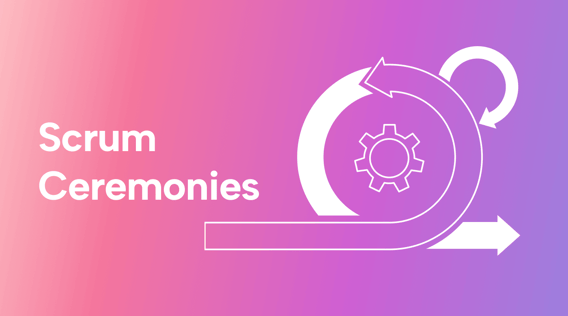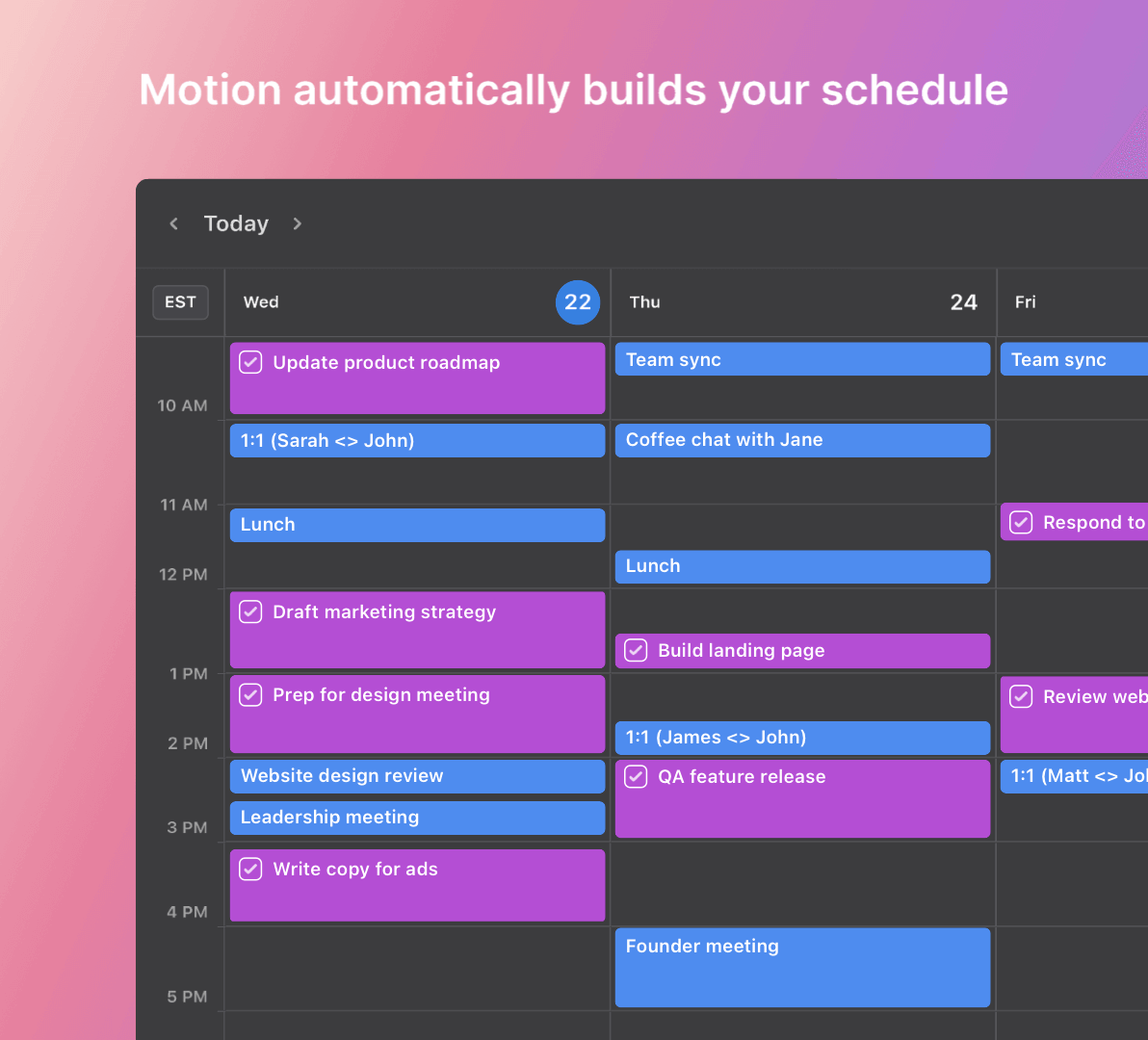Are you fighting to keep your team on track and focused on your project goals? Managing a project can be tough, especially when working with a large team or on a long-term project. Fortunately, Scrum ceremonies can help.
Scrum is a well-known Agile project management framework many businesses use to improve productivity and collaboration. At the heart of Scrum are its five ceremonies, named:
- Sprint planning
- Daily Scrum
- Sprint review
- Sprint retrospective
- Backlog refinement
Below, we'll define each ceremony, explain their uses, and provide tips to make them more effective. By the end, you'll have a clear understanding of how Scrum ceremonies work and how to integrate them into your project management process.
Let’s dive right in.
What are Scrum ceremonies?
Scrum ceremonies are the backbone of the “Scrum” Agile project management framework.
They are the scheduled checkpoints that keep your team aligned and accountable.
Think of Scrum ceremonies like a team huddle in a rugby game. Just like how the rugby team comes together to plan, strategize, and review their game. A Scrum team has different ceremonies to plan, coordinate, and review their work.
During the sprint planning ceremony, the team decides what they will accomplish during the upcoming sprint. The daily Scrum allows team members to share updates and identify any blockers. The sprint review enables the team to showcase their completed work to stakeholders. And the sprint retrospective is a time for reflection and identification of areas for improvement.
In short, Scrum ceremonies help to promote transparency, collaboration, and communication, all of which are essential for success in a project.
Benefits of Scrum ceremonies
Scrum ceremonies provide various benefits and are integral to the success of the Scrum framework.
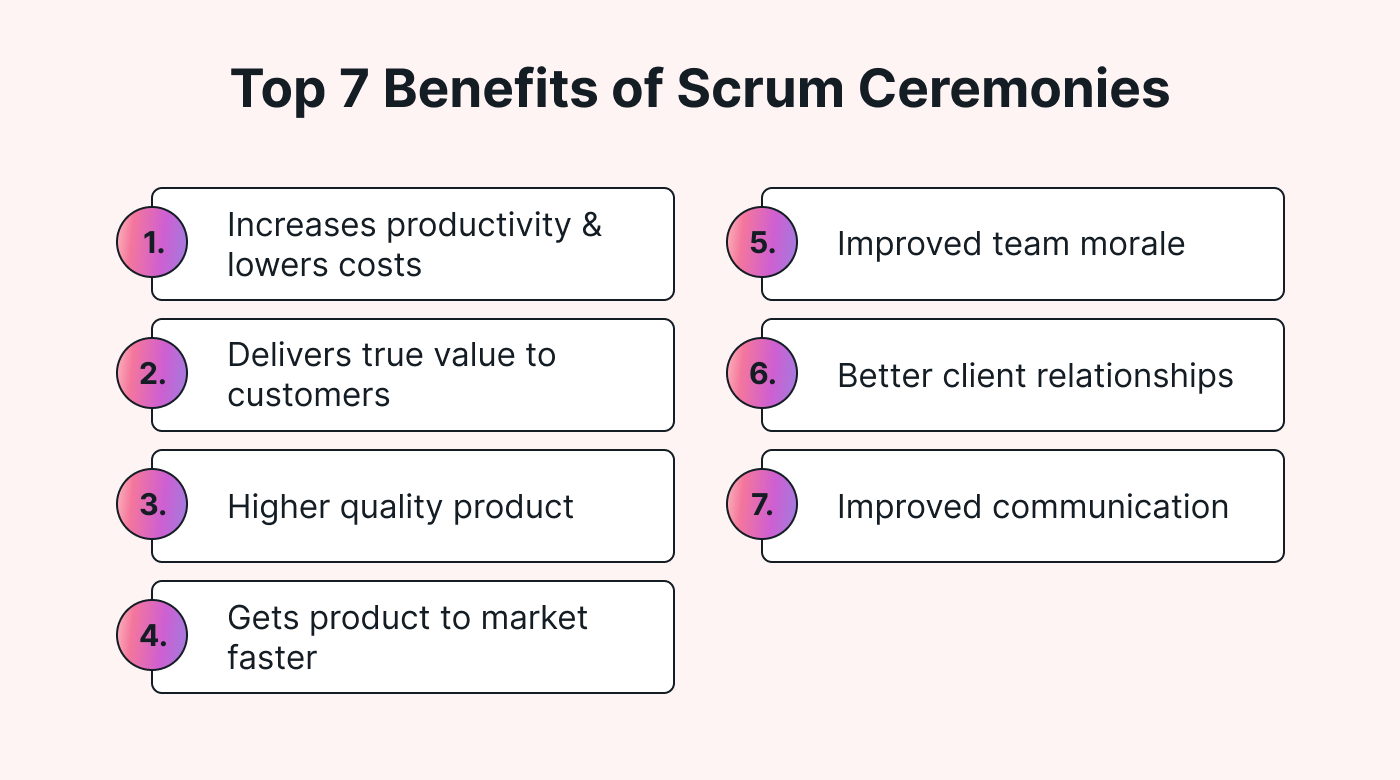 |
Here are some essential benefits of Scrum ceremonies:
- Increased productivity & lower costs: Helps teams focus on work, reduces wasted time, and avoids costly rework.
- Deliver true value to customers: Allows teams to identify and prioritize features based on customer needs. This process ensures the product delivers value.
- Higher quality products: Scrum ceremonies help teams catch issues early and incorporate feedback throughout development. This results in higher-quality products.
- Faster time-to-market: The mindset of continuous delivery allows Scrum teams to release features as soon as they are ready.
- Improved team satisfaction: Scrum ceremonies promote a collaborative and transparent work environment, improving team morale and job satisfaction.
- Better client relationships: By incorporating feedback and delivering high-quality work, Scrum teams can build better relationships with clients and stakeholders.
- Improved communication: Scrum ceremonies encourage open and honest communication between team members, helping to build trust and avoid misunderstandings.
Other advantages of Scrum include:
- Increased adaptability and flexibility to changing requirements
- Increased visibility into project progress and potential risks
- Improved team self-organization and autonomy
Additionally, Scrum can help promote a culture of continuous improvement and learning within a team.
The 5 Scrum ceremonies explained
In Scrum, a sprint is a fixed-length period of time (usually 1–4 weeks). During the sprint, the Scrum team works to complete a set of tasks from the product backlog, which is a prioritized list of work items.
Below is a quick breakdown of the five ceremonies before we look deeper into each.
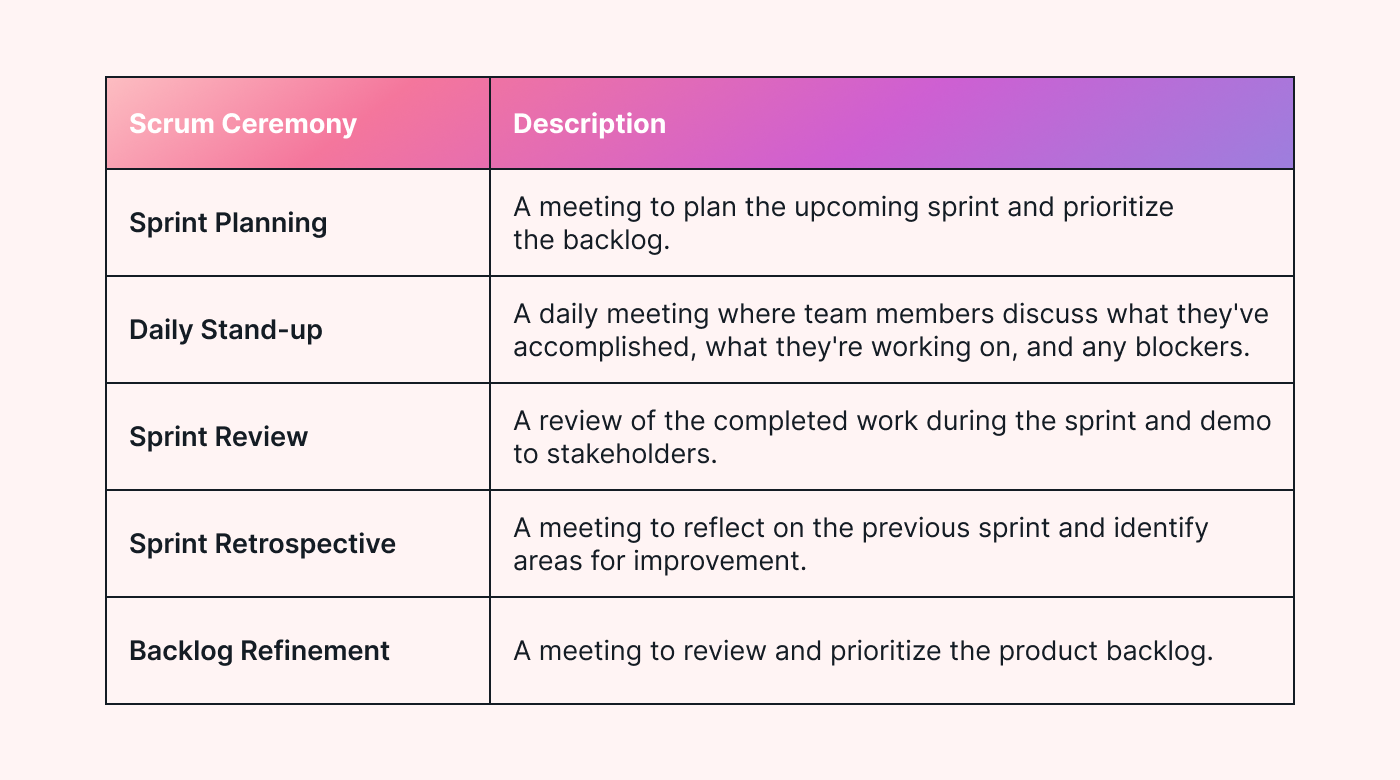 |
Now, let’s take a look at each of these individually.
Sprint planning
The team collaborates during the sprint planning ceremony to identify and prioritize tasks. The Scrum Master facilitates the meeting, and the entire team, including the product owner, developers, and other stakeholders, should participate. The goal is to have a shared understanding of what needs to be done during the sprint and to set realistic goals for the team.
The sprint planning meeting starts with a review of the product backlog, where the team works together to prioritize and refine items. The team then estimates the work involved in completing the tasks, breaking them into smaller, more manageable tasks.
The team also identifies potential obstacles or dependencies affecting the sprint goals. By the end of the meeting, the Scrum team should have a clear plan and a set of goals for the upcoming sprint cycle.
It's important to note that the sprint planning ceremony should be time-boxed and focused on the goals for the upcoming sprint.
A typical Sprint Planning meeting for a two-week sprint should last between one and two hours.
The daily Scrum
The daily Scrum or “daily standup” ceremony is about keeping everyone on the same page by reviewing progress and planning for the day ahead.
 |
It's a brief meeting every working day of the sprint and typically lasts up to 15 minutes.
All Scrum team members, including the Scrum master, developers, and product owner, should attend the daily Scrum. However, it's not limited to these members, as the team can benefit from anyone's input.
During the daily Scrum, team members share updates on their work and any obstacles that might be in their way. This review allows everyone to stay up-to-date on progress, identify potential issues, and adjust as needed.
With everyone aligned and informed, the team can move forward with confidence and focus.
The sprint review
The sprint review is a crucial Scrum ceremony for ensuring stakeholders are updated on the project's progress.
During this meeting, the Scrum team demonstrates the work they've completed during the sprint. They also wait for and work on feedback from stakeholders.
The team also reviews the product backlog and discusses what tasks should be prioritized for the next sprint.
The sprint review allows the team to identify any issues or challenges that need to be addressed before the start of the next sprint.
All stakeholders must attend the meeting to provide feedback and clearly understand the project's current state.
The meeting typically lasts 30–60 minutes and can be held in person or virtually.
The sprint retrospective
Now that we've covered sprint planning, daily Scrum, and sprint review, let's take a closer look at the sprint retrospective.
The sprint retrospective meeting is held at the end of the sprint. It is an opportunity for the team to reflect on the sprint and identify opportunities for process improvement.
The main goal is to figure out what went well and what didn't and how the team can work together more in the future toward a more successful sprint.
During the retrospective, team members share their thoughts and opinions openly and honestly about the sprint. At the same time, the Scrum master facilitates the discussion and helps the team come up with action items for improvement.
It's important to involve as many team members as possible in the sprint retrospective to ensure everyone has a voice and is accountable.
Taking 30–45 minutes for each week of the sprint is a good general rule. This will ensure that the team has enough time to discuss and identify opportunities for improvement.
The backlog refinement ceremony
The product backlog refinement ceremony aims to refine and prioritize the product backlog for upcoming sprints.
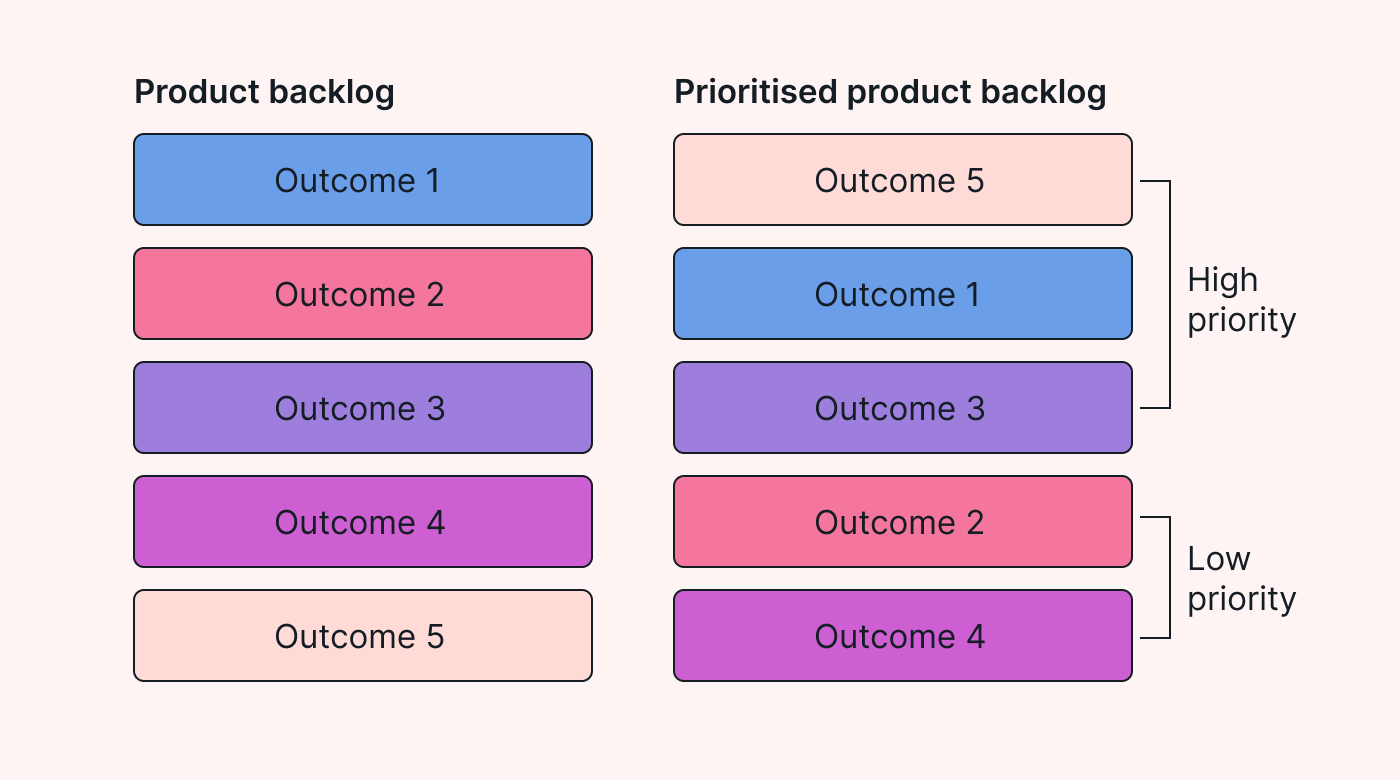 |
During the backlog refinement ceremony, the entire Scrum team reviews the product backlog items. This is so they can assess their value and priority.
They may add new items, remove outdated ones, or break down larger items into smaller, more manageable tasks. This process helps ensure that the backlog is always up-to-date. And that it contains the most valuable and relevant work items for the upcoming sprints.
Product backlog refinement can also be used to ensure that the team is prepared for future sprints and that everyone is on the same page regarding project goals and priorities. By refining the backlog, the team can maximize their efficiency and focus on delivering value to the customer.
How Motion makes Scrum ceremonies effortless
Motion is an Agile project management tool that automates and streamlines Scrum ceremonies.
With Motion, Scrum teams can easily plan, track, and manage sprints, backlogs, and daily activities. The tool provides a simple and intuitive interface for managing all the Scrum ceremonies.
Motion also provides real-time collaboration features, so teams can easily communicate and share updates on tasks, backlog items, and project progress without switching among different tools or platforms.
Additionally, Motion offers customizable workflows and automation features that allow Agile teams to streamline their processes and save time. For example, teams can set up the AI task manager to organize and optimize everyone's schedule for sprint deadlines, backlog item changes, or task updates, ensuring everyone is on the same page.
Get ready to plan your own Scrum ceremonies
Scrum ceremonies are essential to the success of Agile projects. They provide a framework for collaborative communication and continuous improvement.
The five Scrum ceremonies, including sprint planning, daily Scrum, sprint review, sprint retrospective, and backlog refinement, each have a specific purpose and should be conducted regularly.
During each ceremony, focus on the specific purpose and encourage effective communication and collaboration among all participants. Take the time to reflect on what worked well and what didn't, and use this feedback to improve the ongoing process continuously.
Remember, the success of Scrum ceremonies depends on the commitment and participation of all team members. With practice and dedication, Scrum ceremonies can help your team deliver high-quality products efficiently and effectively.
Ready to start planning your own Scrum ceremonies? Sign up for a Motion free trial today and streamline your Scrum process.

